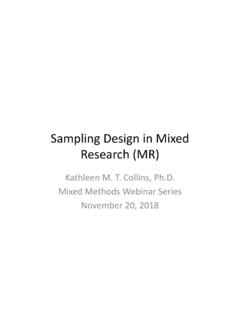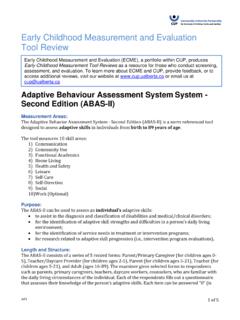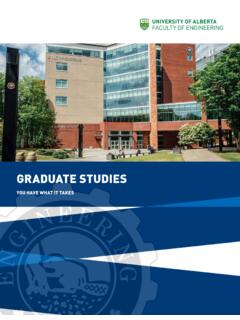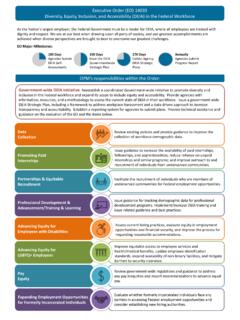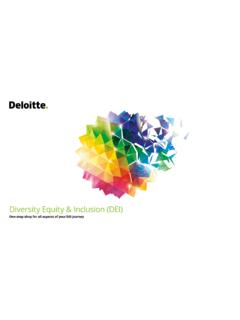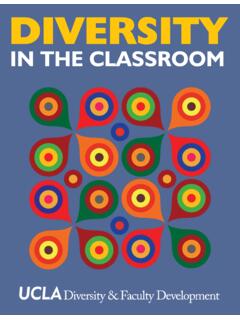Transcription of STRATEGIC PLAN FOR EQUITY, DIVERSITY, AND INCLUSIVITY
1 STRATEGIC PLAN FOR equity , diversity , AND INCLUSIVITYThe University of Alberta respectfully acknowledges that we are located on Treaty 6 territory, traditional lands of First Nations and M tis University of Alberta has a long history of work in support of equity , diversity , and INCLUSIVITY (EDI) in programming, services, teaching and learning, scholarship, and EDI STRATEGIC plan builds on that history, while also reflecting the commitments incorporated in For the Public Good to advance EDI and build respectful relations across and among our people, disciplines, faculties, and campuses, as well as beyond our institution. At our university, we are dedicated to achieving a more diverse, equitable, accessible, and inclusive environment for all who work, learn, and live within our community an environment characterized by a fundamental shared commitment to respectful engagement and human dignity.
2 We value academic freedom, and welcome and support a diversity of STRATEGIC plan aims to embed EDI into the culture of the University of Alberta community, from the grassroots to the senior-most levels. It sets out STRATEGIC directions and senior-level accountabilities that are intended to empower faculties, departments, and administrative units across the university to develop and implement their own EDI plans and initiatives. It includes a set of proposed structures and approaches with explicit desired outcomes that will support efforts across our community as we seek to become more diverse, equitable, and inclusive. However, this is not a top-down achieve our goals, every member of the University of Alberta has a role to play. To weave EDI into the fabric of our culture, each of us must develop plans and initiatives at the local level.
3 We must take deliberate action informed by the best available evidence and institutional data. Working together, we can ensure EDI thrives in our community and enriches the lives of University of Alberta is committed to cultivating an institutional culture that values, supports, and promotes equity , human rights, respect , and accountability among faculty, staff, and students. In our inclusive community, we encourage and support individual and collaborative efforts to identify and address inequities, and we welcome and enable contributions of all voices as we engage with diverse ideas, knowledges, and perspectives in the pursuit of inclusive excellence for the public University of Alberta will work to achieve an accessible, equitable, and inclusive community of students, faculty, and staff that supports our learning environment shaped by curiosity, rigorous inquiry, and evidence-based decision making, respect , and a culture of human rights.
4 We are committed to achieving equitable access and opportunities in admissions, employment, retention, and advancement; and to a working, learning, and living environment free from discrimination, bullying, and harassment. It is only through such a commitment that the University of Alberta can reach our larger vision of being a space that actively fosters intellectual curiosity, rigorous inquiry, and envision and will cultivate a community that recognizes equity and diversity as fundamental to achieving inclusive excellence in learning, teaching, research, service, and community acknowledge this commitment requires identifying and addressing formal and informal obstacles, barriers, and biases that limit equitable access and opportunities, as well as intentionally pursuing and implementing system-wide equity initiatives to embed diversity in all university structures, programs, policies, and practices, as well as in our visual and text to influence those formal and informal structures and mechanisms that limit access and opportunities.
5 We will use principles of fairness and evidence-based policies and practices to support decision-making; collect and analyze diversity data; establish equity goals, targets, and benchmarks; and develop and implement policies. Recognizing that achieving EDI goals requires responsible and accountable leadership at all levels of the university, we will regularly evaluate and report on progress toward achieving an equitable and inclusive OF ALBERTAPRINCIPLESP rinciples are more fundamental than institutional policies and objectives. They inform policies, procedures, and objectives; they help us determine the University of Alberta s STRATEGIC goals, objectives, and actions. All of our principles and actions are underpinned by respect for the dignity, rights, and full participation of all those who live, work, and learn within the university.
6 The university s EDI STRATEGIC Plan is guided by the following principles:DiversityEquityInclusionHuman RightsEquality - substantiveIntersectionalityAccessibilit yRespect for reconciliation with Indigenous peoples5 STRATEGIC PLAN FOR equity , diversity , AND INCLUSIVITYDIVERSITYD iversity refers to difference or variety. In a broad societal EDI context, diversity refers to demographic or identity diversity , including that based on the protected grounds. Within universities, diversity encompasses these, as well as difference or variety in education, perspectives, opinions, heuristics, disciplines, faculties, skills, and learning opportunities. The University of Alberta supports and encourages diversity through the identification and removal of barriers and biases, and the creation of workplaces and learning environments that are free of harassment and is about fairness in access to education and employment and in the opportunity to succeed in these domains.
7 Employment equity principles, policies, and practices enable equitable access, representation, opportunities, and meaningful participation of socially diverse people from the federally designated and other equity -seeking groups such as women, members of visible minority groups, Indigenous peoples, persons with disabilities, and LGBTQ2S+ recognize that policies, practices, informal processes, and language created by and for particular groups of people, with a default norm in mind, produce structural barriers that limit access and inclusion for other individuals and groups. Taking equity as a guiding principle means that the university will respect and value the differences of our members by actively identifying and removing barriers, including structural barriers, to ensure that historically excluded groups have the same opportunity to fully flourish at the University of means that we value and cultivate full and meaningful engagement of historically and structurally excluded individuals and groups.
8 Inclusion refers to enabling all individuals on our campuses to fully enjoy the opportunities the university has to offer, and to have all equity -seeking groups meaningfully represented in all aspects of university life and decision-making roles university RIGHTSE very person, by virtue of being human, is entitled to certain fundamental rights regardless of race, colour, ancestry, place of origin, religious beliefs, gender, gender identity and gender expression, physical disability, mental disability, marital status, family status, sexual orientation, age, political beliefs, and any other protected ground as amended over time. Each person is entitled to a life of dignity, equality, and respect , free from discrimination, harassment, and bullying. The university s commitment to human rights is reflected in its policies and practices, as well as the supports it makes available to the members of its OF ALBERTAEQUALITY - SUBSTANTIVEThe University of Alberta embraces a substantive approach to equality this means that achieving equality is not only a matter of treating likes alike (formal equality), but also requires us to consider and address the range of conditions that create experiences of disadvantage for some individuals and groups.
9 We consider the full context and impacts of our practices and processes, recognizing that these may be experienced differently by different individuals and intersectional approach to equity , diversity , and INCLUSIVITY begins from the understanding that the different vectors of social diversity , (race, class, gender, sexuality, disability, nationality, religion, language, age, etc.) do not exist separately or in isolation from each other. Instead, the various vectors of social diversity are interwoven and affect each other. Intersectionality focuses on how multiple, interwoven vectors shape social belonging, cultural representations, social and political institutions, as well as the material conditions of our lives in ways that are not reducible to any singular vector or social category. Initially developed by women of colour seeking to understand how their existence and experiences of marginalization could not be reduced to gender or racial categorization alone, today we understand that everyone s life is shaped by intersecting social categories.
10 Intersecting social categories play a role in exclusion and shape social, political, and material marginalization and dominance. Experiences and systems of persistent social inequality cannot be understood without an intersectional refers to the degree to which physical, pedagogical, and administrative structures of the University of Alberta are (re)designed to enable the full, meaningful, and equitable engagement of all of the university s community members. Accessibility includes, but is much broader than, ramped access to buildings. It also includes, for example, designing for physical, financial, sensory, social, and language-level access. Whereas accommodation refers to making specific changes to support the full participation of an individual who has encountered barriers, an accessible campus is one that seeks pro-actively to reduce as many barriers as possible, while creating efficient and transparent processes for individuals to gain the accommodations they require and are entitled to by WITH INDIGENOUS PEOPLESR econciliation refers to a process of building and sustaining respectful, ethical relationships between Indigenous peoples and the rest of Canada based on mutual understanding and respect .



